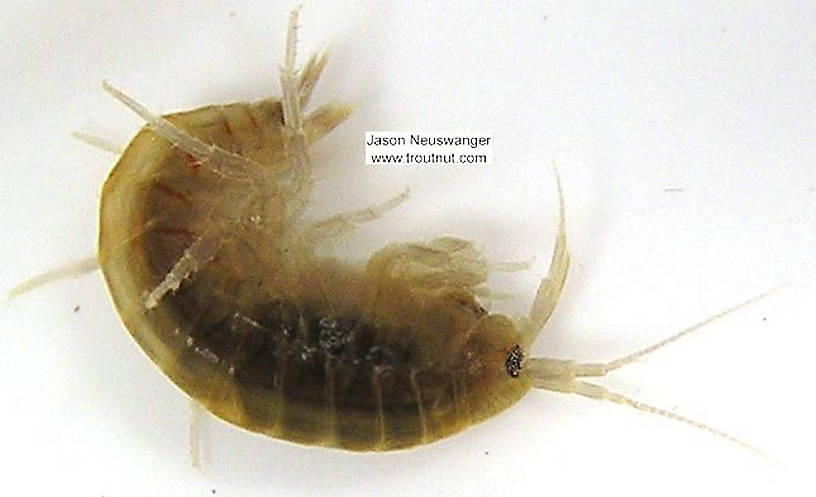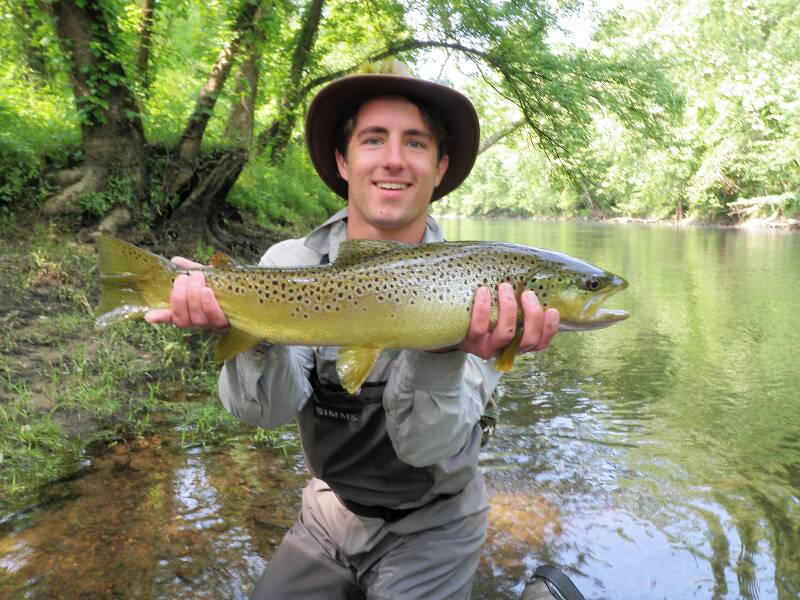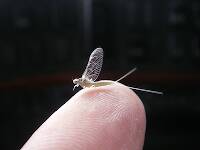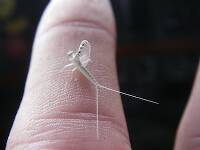
Blue-winged Olives
Baetis
Tiny Baetis mayflies are perhaps the most commonly encountered and imitated by anglers on all American trout streams due to their great abundance, widespread distribution, and trout-friendly emergence habits.
Featured on the forum

This species was fairly abundant in a February sample of the upper Yakima.

Troutnut is a project started in 2003 by salmonid ecologist Jason "Troutnut" Neuswanger to help anglers and
fly tyers unabashedly embrace the entomological side of the sport. Learn more about Troutnut or
support the project for an enhanced experience here.
Jordash on Jun 26, 2008June 26th, 2008, 5:11 pm EDT
i have always wondered where the orange comes from in a scud ? i heard once that when they died they turned orange but i didnt think that sounded right does any one know the right answer
Konchu on Jun 27, 2008June 27th, 2008, 2:19 am EDT
Probably beta-carotene. This is the same compound that is found in carrots and the substance that give flamingos their color.
The color of a scud depends on the age of the individual, its diet and the temperature of its surroundings.
The color of a scud depends on the age of the individual, its diet and the temperature of its surroundings.
Flyfanatic on Jan 11, 2009January 11th, 2009, 7:20 am EST
The Orange color in the scud is eggs. When scuds get pregnant, they carry the eggs under their belly giving off the Orange look.
Rick Passek
Rick Passek
Tight Line & Fun Times
Martinlf on Jan 11, 2009January 11th, 2009, 11:43 am EST
Scuds with an orange dot in the center are females with eggs. Solid orange scuds are dead.
"He spread them a yard and a half. 'And every one that got away is this big.'"
--Fred Chappell
--Fred Chappell
Ljnbass on Jan 19, 2010January 19th, 2010, 12:50 pm EST
I remember reading this somewhere. I think it was in one of Earnest Schweibert's or Gary Borger's " Designing Trout Flies ". Got me wondering. I'll look it up and let you know.
Redtag on Feb 11, 2012February 11th, 2012, 8:40 am EST
Water shrimps (scuds) are parasitized by worms which cause them to develop red spots on their body and also to change their behavior
Jesse on Feb 11, 2012February 11th, 2012, 12:39 pm EST
Eggs, thats interesting i never knew that!
Most of us fish our whole lives..not knowing its not the fish that we are after.
http://www.filingoflyfishing.com
http://www.filingoflyfishing.com
Silverexprs
Posts: 1
Posts: 1
Silverexprs on Sep 1, 2012September 1st, 2012, 9:18 am EDT
How would you guys go about fishing this?
Entoman on Sep 1, 2012September 1st, 2012, 4:47 pm EDT
Hi Silverexprs,
Welcome to the forum!
The answer depends on water type.
On still waters I usually fish them deep with a short twitching retrieve on a long leader/tippet near weed beds. Some advise the occasional pause (as do the naturals), but I don't do this as my patterns are heavy enough that they sink too rapidly in an unnatural manner when paused. Use of sinking lines to obtain depth and the use of lighter flies would allow this, but I like the visual aspects of looking for the twitching leader. If there is a breeze making it difficult to see the leader (there often is with cloudy weather), I use an indicator and fish the fly slower as the riffle will apply some action to the fly. Capture samples for a given body of water to dictate size and color. A bug net swished in the weeds will bring up plenty of samples if they are present and available as a food source worth imitating. I use specialized imitative patterns to match the naturals.
On moving water, I generally fish them dead drift. There are a few spring creeks where the more imitative flies are perhaps best, but I generally rely on the Zug Bug, Bird's Nest and especially a heavily weighted Sawyer's Killer Bug.
Having said all of the above, IMO the only time they are worth fooling with are when populations actually exist in worthwhile numbers and when I'm on the water fishing during the low light of dawn, dusk or cloudy days. During the bright midday hours, they are buried pretty deep in the weeds and unavailable except to "rooting" fish.
Best regards,
Welcome to the forum!
The answer depends on water type.
On still waters I usually fish them deep with a short twitching retrieve on a long leader/tippet near weed beds. Some advise the occasional pause (as do the naturals), but I don't do this as my patterns are heavy enough that they sink too rapidly in an unnatural manner when paused. Use of sinking lines to obtain depth and the use of lighter flies would allow this, but I like the visual aspects of looking for the twitching leader. If there is a breeze making it difficult to see the leader (there often is with cloudy weather), I use an indicator and fish the fly slower as the riffle will apply some action to the fly. Capture samples for a given body of water to dictate size and color. A bug net swished in the weeds will bring up plenty of samples if they are present and available as a food source worth imitating. I use specialized imitative patterns to match the naturals.
On moving water, I generally fish them dead drift. There are a few spring creeks where the more imitative flies are perhaps best, but I generally rely on the Zug Bug, Bird's Nest and especially a heavily weighted Sawyer's Killer Bug.
Having said all of the above, IMO the only time they are worth fooling with are when populations actually exist in worthwhile numbers and when I'm on the water fishing during the low light of dawn, dusk or cloudy days. During the bright midday hours, they are buried pretty deep in the weeds and unavailable except to "rooting" fish.
Best regards,
"It's not that I find fishing so important, it's just that I find all other endeavors of Man equally unimportant... And not nearly as much fun!" Robert Traver, Anatomy of a Fisherman
Martinlf on Sep 1, 2012September 1st, 2012, 5:15 pm EDT
Kurt, what yarn do you use for your Killer Bug? You'll know the history and why I ask this.
"He spread them a yard and a half. 'And every one that got away is this big.'"
--Fred Chappell
--Fred Chappell
Entoman on Sep 1, 2012September 1st, 2012, 6:25 pm EDT
Sure do! I don't use yarn. After searching the world (or so it seems), never came across one that even comes close.:) So, I experimented & experimented until I came up with a dubbing blend that matches the heathered tan color with a pinkish cast about as perfectly as possible. I think it looks even better from a texture standpoint. Even if I had a skein of the old Chadwick's 477 (only have about six inches left, kept for reference), I'd still use this stuff. Besides, I could sell the skein on Ebay for enough to pay for a fishing trip! :)
Dubbing blend - 50% Hareline hare's ear, 50% tan "Buggy Nymph", a smidgen of red angora goat
You can tie the fly conventionally by using copper wire and starting the dubbing at the head and tying it off at the tail with the wire, but I use pink or tan 6/0 Danville's tying thread over 16 wraps of .020 lead wire (size 12 hook). Using copper wire in the tying as per Sawyer would work better on waters like the Avon I suppose, but I find this method more successful on our heavier western rivers. When you've covered the lead to the point that it's mostly hidden, apply the dubbing thickly and dub it tightly as possible with your fingers (about 3" or so). Do it in layers rather than all at once so you can build a tighter, more consistent noodle. Form a loop by hooking the thread below the dubbing with a spinning tool and wrap the tread around the shank a few times. Now spin it up tight clockwise if you're right handed. Wrap forward and tie off. It takes a few to get the amount of dubbing to apply, but once you do, it's the easiest fly in the world to tie (most guys tie them too thin, IMO). The photo below makes the fly look pinker and lighter than it actually is, but you get the idea of the texture and look of the finished fly.

Dubbing blend - 50% Hareline hare's ear, 50% tan "Buggy Nymph", a smidgen of red angora goat
You can tie the fly conventionally by using copper wire and starting the dubbing at the head and tying it off at the tail with the wire, but I use pink or tan 6/0 Danville's tying thread over 16 wraps of .020 lead wire (size 12 hook). Using copper wire in the tying as per Sawyer would work better on waters like the Avon I suppose, but I find this method more successful on our heavier western rivers. When you've covered the lead to the point that it's mostly hidden, apply the dubbing thickly and dub it tightly as possible with your fingers (about 3" or so). Do it in layers rather than all at once so you can build a tighter, more consistent noodle. Form a loop by hooking the thread below the dubbing with a spinning tool and wrap the tread around the shank a few times. Now spin it up tight clockwise if you're right handed. Wrap forward and tie off. It takes a few to get the amount of dubbing to apply, but once you do, it's the easiest fly in the world to tie (most guys tie them too thin, IMO). The photo below makes the fly look pinker and lighter than it actually is, but you get the idea of the texture and look of the finished fly.

"It's not that I find fishing so important, it's just that I find all other endeavors of Man equally unimportant... And not nearly as much fun!" Robert Traver, Anatomy of a Fisherman
Entoman on Sep 2, 2012September 2nd, 2012, 10:08 am EDT
"It's not that I find fishing so important, it's just that I find all other endeavors of Man equally unimportant... And not nearly as much fun!" Robert Traver, Anatomy of a Fisherman
Entoman on Sep 4, 2012September 4th, 2012, 10:19 pm EDT
Louis,
Those two photos point out how different the same fly may look in different conditions - one photo wet and backlit (trout looking up?), the other dry and in the hand. In retrospect, I don't think this is due to camera aberration. Hmm... This may be evidence/example that Sawyer's speculation that his tan fly took on a pinkish cast to the fish when wet (due to a few red fibers in the yarn) and led to their excitement? Other examples of this phenomena are replete in discussions of fly color in our literature. A study of highly successful flies photographed wet and backlit vs. dry and in the hand would be interesting...
Those two photos point out how different the same fly may look in different conditions - one photo wet and backlit (trout looking up?), the other dry and in the hand. In retrospect, I don't think this is due to camera aberration. Hmm... This may be evidence/example that Sawyer's speculation that his tan fly took on a pinkish cast to the fish when wet (due to a few red fibers in the yarn) and led to their excitement? Other examples of this phenomena are replete in discussions of fly color in our literature. A study of highly successful flies photographed wet and backlit vs. dry and in the hand would be interesting...
"It's not that I find fishing so important, it's just that I find all other endeavors of Man equally unimportant... And not nearly as much fun!" Robert Traver, Anatomy of a Fisherman
Quick Reply
Related Discussions
Topic
Replies
Last Reply
10
Jul 27, 2008
by Phillyfired
by Phillyfired









